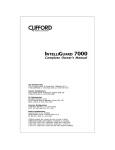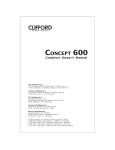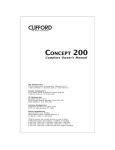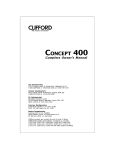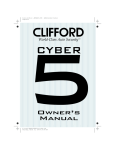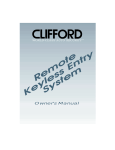Download Clifford Eagle II User's Manual
Transcript
World-Class Auto Security TM Owner's Manual Table of Contents Standard Features of the Eagle II . . . . . . . . . . . . . . . . 3 Welcome . . . . . . . . . . . . . . . . . . . . . . . . . . . . . 6 Your 4-button/12-channel remote controls . . . . . . . . . . 6 How to use your keychain remote control . . . . . . . . . 6 Anti-CodeGrabbing (ACG) with Random Code Encryption . 9 Tamper-proof dual-point AutoImmobilisation . . . . . . . . . 9 Dual-sensor protection . . . . . . . . . . . . . . . . . . . . . 9 AutoLock/AutoUnLock AutoArming . . . . . . . . . . . . . . . . . . . . . 9 . . . . . . . . . . . . . . . . . . . . . . . . . . 10 AutoArming enable/disable . . . . . . . . . . . . . . . . 10 AutoArm & Lock . . . . . . . . . . . . . . . . . . . . . . . 10 Visual Acknowledgment . . . . . . . . . . . . . . . . . . 10 Instant AutoArming bypass . . . . . . . . . . . . . . . . . 10 Valet mode . . . . . . . . . . . . . . . . . . . . . . . . . . To enable valet mode To exit valet mode 10 . . . . . . . . . . . . . . . . . . . 10 . . . . . . . . . . . . . . . . . . . . . 10 Remote controlled valet mode entry and exit . . . . . . . 11 Keyless entry in valet mode . . . . . . . . . . . . . . . . . . 11 1 Table of Contents (cont.) FACT — False Alarm Control and Test . . . . . . . . . . . . 11 Smart boot release option . . . . . . . . . . . . . . . . . . 11 Smart prior intrusion attempt alert . . . . . . . . . . . . . . 11 Smart AutoTesting . . . . . . . . . . . . . . . . . . . . . . . 12 Automatic malfunction bypass . . . . . . . . . . . . . . . 12 TotalRecall . . . . . . . . . . . . . . . . . . . . . . . . . . . 12 SmartPowerUp II . . . . . . . . . . . . . . . . . . . . . . . . 12 How to interpret the chirps and indicator light flashes . . . 13 How to interpret the LED status indicator . . . . . . . . . . 13 High-output six-sound siren . . . . . . . . . . . . . . . . . 13 Long-term chirp silencing . . . . . . . . . . . . . . . . . 13 Remote controlled chirp muting . . . . . . . . . . . . . . 13 Siren duration . . . . . . . . . . . . . . . . . . . . . . . . 13 User-selectable features . . . . . . . . . . . . . . . . . . . 14 Programming Table for user-selectable features . . . . . 14-15 Adding new remote controls . . . . . . . . . . . . . . . . . 15 How to erase the codes of lost or stolen remote controls 15 2 . Standard Features of the Eagle II ✔ Lifetime Warranty — For as long as you own the vehicle, Clifford will repair or replace the control unit and remote controls free of charge (see warranty card for full details). — One of many patented Clifford innovations, FACT absolutely, positively ends recurring false alarms. ✔ FACT — False Alarm Control and Test ✔ A Pair of 4-Button/12-Channel Remote Controls —For fingertip command from a distance. ✔ AntiScan — Some car thieves still use “scanners” that transmit one digital code after another until they hit the one code that disarms the alarm. AntiScan blocks scanners to prevent disarming by anyone other than you. ✔ Anti-CodeGrabbing (ACG) with Random Code Encryption — A “code- grabber” lets a thief record from a distance the digital code transmitted by your remote control whenever you arm your car. When you leave, the thief replays the code to disarm the alarm and unlock your car’s doors. ACG with Random Code Encryption makes thieves’ code-grabbers useless, because each time you press the button on your remote control a different random code is transmitted, yet the system will flawlessly recognise and respond to your transmitter’s new code and ignore all others. ✔ Full-Time Remote Panic with Automatic Door Locking and Unlocking— If you feel threatened, a fingertip touch on your remote control will sound the siren, flash the indicator lights and unlock your vehicle’s power door locks for quick entry into your car without fumbling with your keys. If you press the panic button while driving, the siren will sound, the lights will flash and the doors will lock to shield you from the assailant. ✔ Dual-Mode Chirp Silencing — Your choice of either long-term chirp silencing or remote controlled chirp muting whenever you wish. ✔ Dual-Sensor Protection — A Piezo Sensor detects intrusion-related vibrations and impacts, while a Proximity Sensor detects any movement inside the passenger compartment. ✔ Remote Controlled Valet Mode Entry and Exit— With just a press of a button on your remote control, you can enter or exit valet mode. Indicator light flashes visually confirm valet mode entry and exit. 3 Standard Features of the Eagle II (cont.) ✔ Tamper-Proof Dual-Point AutoImmobilisation —While the Eagle II is armed, the entire ignition and starter systems are immobilised. For unmatched security, even if a thief were to cut all the alarm wires, he would still be unable to start the engine. ✔ Remote Door Lock/Unlock Capability — No more fumbling with keys in the dark or bad weather! A press of a button on the remote simultaneously arms your system and locks your vehicle’s power locks. Another press disarms and unlocks. — Automatically locks the doors when you start the engine, and automatically unlocks them when you turn it off. User-Selectable AutoLock/AutoUnLock — Remotely lock and unlock the doors and activate system accessories even while the system is in valet mode. Deluxe Remote Keyless Entry in Valet Mode ✔ Remote Controlled Courtesy Lighting — For your safety and convenience, when you remotely disarm your Eagle II, the interior lights turn on and stay on until you start the engine or for 30 seconds, whichever occurs first. ✔ Built-In Indicator Light Flasher — Visually confirms lock and system status. ✔ Patented AutoTesting — Automatically tests all system triggers and sensors every time you remotely arm and warns you if you accidentally arm your Eagle II system with the bonnet or boot open. ✔ Patented Malfunction AutoBypass —In the unlikely event of a trigger or sensor malfunction, Eagle II will automatically bypass the malfunction and arm all other points to continue relentless protection of your vehicle. ✔ Patented Prior Intrusion Attempt Alert — When you return to your vehicle and remotely disarm your Eagle II, a special chirp and indicator light flash sequence will audibly and visually alert you from a distance if an intrusion attempt was foiled while you were away. ✔ High-Output Six-Sound Siren — Loud siren wail with six different alarm sound patterns for unmistakable recognition from a distance. — Limits alarm sounding to no more than 5 minutes even if a door is left open in the wake of an intrusion attempt. Patented Automatic Noise Abatement Selectable Siren Duration — Your choice of either a 30- or 60-second siren wail. 4 Standard Features of the Eagle II (cont.) ✔ User-Selectable AutoArming— Automatically arms itself “passively” if you forget to arm it with the remote control. — You may disable or re-enable AutoArming with just a few flicks of a switch. AutoArming Enable/Disable — You may set the system to automatically lock the doors every time the system AutoArms. AutoArm & Lock — Just two quick turns of the ignition switch will bypass AutoArming for one cycle — perfect when fueling the vehicle. AutoArming is automatically restored the next time you park your vehicle. Instant AutoArm Bypass ✔ Smart Remote Boot Release Capability — An electronic interlock assures that the optional remote boot release can be activated only when the system is disarmed. To further prevent any possibility of unintentional opening of the boot, the interlock also makes sure that the boot release cannot be remotely activated while driving. — Just a few flicks of a switch lets you match to the system up to 4 different 12-channel ACG Clifford remote controls. Just as easily, a lost or stolen remote control can be deleted from the system memory. ✔ Patented Remote Control Code Learning with MultiRemote Recognition ✔ Multiple-Car Control— You can interface your 4-button/12-channel remote control with Eagle II systems on as many as ten of your vehicles. ✔ Control Unit with 4 Channels— For remote controlled system operation and remote control of optional accessories. ✔ Bonnet/Boot Trigger Input— For full perimeter protection of the engine compartment and boot contents (may require optional pin switches). ✔ High-Luminescence LED Status Indicator — Adds visual deterrence and identifies system status. ✔ Patented SmartPowerUp II — When power to the system is disconnected, the system’s non-volatile memory always remembers the last state (armed, disarmed or valet mode) and returns to that state when power is restored. So if a thief disconnects the power and then restores it in an attempt to start the car, the system will re-arm and instantly sound the siren while immobilising the vehicle. 5 C Welcome to the world of high-technology vehicle security and convenience ongratulations on the purchase of your Eagle II. Clifford Electronics has long been recognised as the world’s leading manufacturer of high-technology vehicle security systems. Buying Clifford has always meant buying the best. In fact, Clifford Electronics holds more patents than all other vehicle security manufacturers combined. Yet despite all its sophistication, you will find your Eagle II system amazingly easy to use: never more difficult than a few flicks of a switch or a press of a button on one of your keychain remote controls. Your 4-button/12-channel remote controls The 4-button/12-channel remote controls are ultra-sophisticated miniature radio transmitters, each powered by a tiny 12-volt battery. A weak remote control battery will reduce range. Electrical interference and even sunspots can interrupt the signal from your remote control to the system. If this happens, repeatedly press the remote control button (this works better than holding the button down). The 4-button/12-channel remote control is the key to your system. It incorporates Clifford’s Anti-CodeGrabbing (ACG) technology for the ultimate protection against “code-grabbing” devices (see page 13). You will use your remote control to arm and disarm the system, lock and unlock the doors, activate the panic feature, adjust sensor sensitivity, enable/exit valet mode, override one or both zones of the Proximity Sensor, command options such as a remote boot release, timed headlight activation, power window operation, electric garage door interface and even remote starting of the engine and heater or air conditioner, among other options. How to use your keychain remote control Your remote control can individually command up to 12 different system functions and options. It’s like having a TV with 12 channels. You change channels (functions) with your keychain remote control. But instead of putting 12 buttons on the remote, we made it easy: First, the button you use the most — button 1 to arm, disarm, lock and unlock — is larger than the others. Buttons 2, 3 and 4 are the smaller buttons to the right, below and left of button 1. The LevelShift button on the side of the remote control allows you to select channels 5–12: continued . . . 6 To transmit either channel 1, 2, 3 or 4: Just press either button 1, 2, 3 or 4. For instance, to transmit channel 3, press button 3. While you transmit, the LED indicator will flash once every second: this indicates level 1. To transmit either channel 5, 6, 7 or 8: Press the LevelShift button once. This shifts buttons 1–4 to level 2 (channels 5–8). Then press the button within the next 7 seconds. For instance, to transmit channel 5, press the LevelShift button once, then press button 1. While you transmit, you’ll notice that the LED indicator flashes twice, pauses, flashes twice, etc.: this indicates level 2. To transmit channel 9, 10, 11 or 12: Press the LevelShift button twice. This shifts buttons 1–4 to level 3 (channels 9–12). Then press the corresponding button within the next 7 seconds. For instance, to transmit channel 10, press the LevelShift button twice, then press button 2. While you transmit, you’ll notice that the LED flashes three times, pauses, flashes three times, etc.: this indicates level 3. NOTE: One second after you stop transmitting level 2 or level 3 (channels 5–12), the remote control automatically returns to level 1 (channels 1–4). What each button/channel does Your Eagle II remote controls are pre-programmed so that certain channels command certain functions. If you wish, you can assign any channel to any function (see User-selectable features on pages 14-15).. The following chart indicates what each remote control channel number does, and how to transmit each channel number. Factory settings of the 12 remote control channels Transmitting channel number: Causes the system to: 1 arm or disarm and lock or unlock the doors Press the How Press LevelShift many button button? times? number no — 1 2 optionally pop the boot (if the system is disarmed) no — 2 3 silently arm or disarm no — 3 4 activate optional accessory function #1 no — 4 5 remotely enter or exit valet mode (see page 15) yes once 1 6 activate optional accessory function #2 yes once 2 7 activate optional accessory function #3 yes once 3 8 activate optional accessory function #4 yes once 4 9 activate optional accessory function #5 yes twice 1 10 activate optional accessory function #6 yes twice 2 11 activate optional accessory function #7 yes twice 3 12 activate optional accessory function #8 yes twice 4 7 TO ARM THE SYSTEM . . . . . . . Press button 1 (channel 1) once. You will hear two chirps and the indicator lights will flash twice. The dashboard LED will flash repeatedly and the car doors will automatically lock. TO DISARM THE SYSTEM . . . . . . . Press button 1 (channel 1) again. One chirp and one indicator light flash confirms disarming. In addition, the doors will automatically unlock and the interior lights will turn on and stay on for 30 seconds or until you start the engine, whichever occurs first. TO SILENTLY ARM OR DISARM THE SYSTEM . . . . . . . Press button 3 (channel 3). Your Eagle II system will arm or disarm with all the indications noted above except for the chirp acknowledgments. TO ACTIVATE THE PANIC FEATURE . . . . . . . . . . Press button 1 (channel 1) for 3 seconds. The indicator lights will flash repeatedly and the siren will blare for 30 seconds or until you press button 1 again. If the ignition is on (indicating you are in the car), the doors will lock to prevent an assailant from entering. If the ignition is off, the doors will unlock, letting you to enter immediately without fumbling with your keys. TO REMOTELY OPEN THE BOOT. . . . Button 2 (channel 2) can control an accessory when the system is disarmed, such as an optional remote boot release. Pressing button 2 while the alarm is disarmed will remotely open the boot. Transmitting channel 2 while the system is armed (or while the ignition is on) will not activate the boot release. This ensures that you can’t accidentally open the boot while driving or false-alarm the system while it’s armed. TO ACTIVATE OTHER OPTIONS. . . . . Button 4 (channel 4) can activate another accessory such as remote power window control, the IntelliStart remote engine/heater/air conditioner starter, etc. TO CONTROL YOUR OTHER VEHICLES . . . . Channels 6–12 (see Your 4-button/12-channel remote controls on page 7) can be programmed to operate Eagle II and Concept Series systems and optional accessories on your other vehicle(s). WHAT ABOUT CHANNEL 5? . . . . . . . Channel 5 can be used to remotely enter or exit valet mode. See pages 9 and 10 for details. 8 Anti-CodeGrabbing (ACG) with Random Code Encryption ACG protects you and your automobile from the most effective and onerous car stealing device ever used by car thieves — a code-grabber. Code-grabbers literally record, from hundreds of meters away, the code sent by your car alarm remote control. Then the thief simply plays back the code when you’re gone, instantly disarming the alarm and unlocking the doors. Your Eagle II has Clifford Electronics’ proprietary ACG technology, which uses complex proprietary digital signal processing and unbreachable encryption to randomly change the digital code every time you use the remote control. Your remote will never transmit the same code twice, and the control unit will never accept the same code twice. Clifford Electronics also offers an optional ACG interface (#64-128/ACG) to your electric garage door/gate opener that not only allows you to command your garage door and/or gate opener(s) via your Clifford remote control, but also protects your garage and home from burglars with code-grabbers. Tamper-proof dual-point AutoImmobilisation While armed, the system assures that your vehicle is completely immobilised by automatically locking out both the ignition system and the starter motor. That means that a thief won’t be able to start the engine even if he had a duplicate of your car key. In fact, even if he were to find the system control unit and tear it out of your vehicle, he still would not be able to start your car’s engine! Dual-sensor protection Your Eagle II system has two sensors: An all-electronic Piezo Sensor that detects intrusion-related vibrations and impacts as well as a Proximity Sensor passenger compartment radar sensor that detects any movement inside the vehicle. Both the Eagle II’s Piezo Sensor and the Proximity Sensor are impervious to the wind and temperature variations that cause ultrasonic and electromechanical sensor to falsely alarm. AutoLock/AutoUnLock For your safety and that of your passengers, the vehicle doors will automatically lock the instant you turn on the ignition switch to start the engine. When you switch off the ignition to shut down the engine, the AutoUnLock feature automatically unlocks the doors. To suit your preferences, the AutoLock/AutoUnLock feature can be disabled or re-enabled (see User-selectable features on pages 14-15). 9 AutoArming If this feature is enabled and you forget to remotely arm, the system automatically arms itself 30 seconds after the vehicle doors are closed. If you re-open any door(s) within the 30-second countdown, AutoArming will restart from the beginning once all doors are closed. Eagle II has these additional AutoArming features: AutoArming enable/disable: If you prefer, you may deactivate or reactivate the AutoArming feature. See User-selectable features on pages 14-15. AutoArm & Lock: To ensure you can’t accidentally lock your keys inside the car, the system is factory-set not to lock the doors upon AutoArming. To change this setting, see User-selectable features on pages 14-15. Visual acknowledgment: Five seconds after you exit the vehicle and close all the doors, the indicator lights will flash twice to confirm that the AutoArming countdown is progressing. Then, 25 seconds later, the system will AutoArm itself. Instant AutoArming bypass: Prevents AutoArming when fueling the vehicle and other times when you wish to temporarily bypass the AutoArming feature. To activate Instant AutoArming Bypass, rapidly turn the ignition switch to “ON” then “OFF” twice. You will hear a single siren chirp to confirm that the system will not AutoArm. Your Eagle II will revert to its normal operating mode when you next start the engine. Valet mode Whenever the system is put in valet mode, all of the system’s security features are switched off. At various times, you will need to turn the system off. For instance, when having your car serviced, washed or parked by a valet. NOTE: If you temporarily lose the use of your remote controls, you can disarm the system by enabling valet mode. To enable valet mode 1. Turn the ignition switch to its “ON” position or start the engine. 2. Flip the valet switch. The system’s LED will glow continually for on-going visual confirmation of valet mode. To exit valet mode 1. Turn the ignition switch to its “ON” position or start the engine. 2. Flip the valet switch. The system’s LED will turn off to confirm that the system is in its normal operating mode. 10 Remote controlled valet mode entry and exit You can even remotely enable or exit valet mode with your 4-button/12-channel ACG remote control. All you need to do is transmit channel 5 (one press of the side LevelShift button, then press button 1). In addition to the previously noted indications, two indicator light flashes will confirm that you have remotely enabled valet mode, while a single flash confirms exiting of valet mode. Keyless entry in valet mode Even in valet mode, you can still remotely control convenience features. For instance, press button 1 (channel 1) as if you were disarming and the doors will unlock (indicated by one indicator light flash) and the interior lights will turn on. Press button 1 again and the doors lock (two flashes). You can also use the other channels to activate options such as a remote boot release or remote engine starting. FACT — False Alarm Control and Test With FACT, you’ll never experience repeated false alarms. If the siren goes off, DO NOT remotely disarm the system; allow it to run for the full 30-second siren duration. Before sounding the siren a second time, the system automatically checks for another activated trigger to verify that an intrusion is in progress. Should the siren sound again, you will know for sure that someone is tampering with your vehicle. (To disable FACT, see User-selectable features on pages 14-15.) Smart boot release option If this option was installed, you may use button 2 (channel 2) to remotely pop the boot. Your system has a built-in electronic interlock to prevent unintentional activation of the remote boot release when you drive or when the system is armed. Smart prior intrusion attempt alert When you remotely disarm, if you hear 3 chirps instead of the usual one chirp it means that a trigger or sensor was activated in your absence. When you turn on the ignition, the LED will flash 1-3 times, pause, then repeat the flash cycle four more times. Refer to the chart below to identify the trigger or sensor activated. LED flashes per cycle Trigger/sensor indicated 1 flash Piezo Sensor or Proximity Sensor 2 flashes Door trigger 3 flashes Boot or bonnet trigger 11 Smart AutoTesting Eagle II automatically tests all triggers and sensors every time you remotely arm. If a trigger is malfunctioning, you will be alerted immediately with 4 chirps and 4 flashes instead of the usual 2 and 2. If a door* is ajar or a sensor is malfunctioning, you will receive the usual 2 chirps and flashes, then, 5 second later, there will be 4 chirps and flashes. If you disarm and turn on the ignition, the LED will flash 1-3 times, pause, then repeat the flash cycle four more times. Refer to the chart below. LED flashes per cycle Trigger/sensor indicated 1 flash Piezo Sensor or Proximity Sensor 2 flashes* Door trigger* 3 flashes Boot or bonnet trigger Automatic malfunction bypass To provide protection even if there is a malfunction, Eagle II automatically bypasses any faulty point and arms all other points to provide the utmost possible protection until you can have the system serviced by your local Authorised Clifford Dealer. TotalRecall The system’s non-volatile memory records the identity of the last activated or malfunctioning trigger or sensor, which allows your installer to instantly track down a malfunction and save you servicing costs. To identify the trigger or sensor: 1. With the ignition OFF, flick the valet switch to one side. 2. Press button I to “arm” the system, then again to “disarm.” 3. The LED will flash several times, pause, then repeat the flash cycle 4 times. 4. Count the number of flashes in one cycle and refer to the chart above. SmartPowerUp II If power to the system is ever removed, SmartPowerUp II ensures the system will automatically restore itself to its previous state when power is restored. So if a thief disconnects the power and then restores it in an attempt to start the car, the system will re-arm and instantly sound the siren while immobilising the vehicle. If your vehicle is to be serviced by a mechanic, just put the system in valet mode via the remote control (see Remote controlled valet mode entry and exit on page 10). If the mechanic needs to interrupt power, your system will automatically return to its valet mode state when power is restored; there will be no alarm activation and no need to provide your mechanic with your remote control and instructions on how to use it. * If your vehicle has a factory-installed feature that turns off or dims the interior courtesy lights several seconds after you exit the vehicle, the system cannot provide this feature. 12 How to interpret the chirps and indicator light flashes When you use the remote control, the system responds with chirps (unless the chirp muting feature is turned on) and indicator light flashes: Chirps and flashes Meaning 1 Your system is disarmed or you have remotely exited valet mode (see above) 2 Your system is armed or you have remotely engaged valet mode (see above) 2 and then 4 Armed but there is a door open or one of the sensors is malfunctioning (see Smart AutoTesting on page 12) 3 Disarmed but there was an intrusion attempt while you were away (see Smart Prior intrusion attempt on page 11) 4 Armed but the bonnet or boot is ajar (see Smart AutoTesting on page 12) How to interpret the LED status indicator The LED on your car’s dashboard or console will inform you of the system status: LED Condition Meaning Off System is disarmed and in normal operating mode (i.e., valet mode is off) On Valet mode is on, the vehicle can be driven or serviced without having to disarm Flashing System is armed and protecting your vehicle High-output six-sound siren Your Eagle II system siren emits six different alarm sound patterns for unmistakable recognition from a distance. In addition, the system also provides these features: Long-term chirp silencing: You may choose to silence the arm/disarm chirps until you decide to restore them. Indicator light flashes will provide visual confirmation of remote arming and disarming. See User-selectable features on pages 14-15. Remote controlled chirp muting: This is especially valuable when parking late at night in a quiet residential area or any other time when you want to arm or disarm silently. To do so, simply press button 3 (channel 3) on your remote control instead of the usual button 1 (channel 1). Siren duration: When the system detects an intrusion attempt, the alarm is set to sound for 30 seconds. However, if you prefer, you may change it to 60 seconds. See the User-selectable features on pages 14-15. 13 User-selectable features Your Eagle II vehicle security system allows you to set many of its features to your own personal preferences. We have made the programming procedures very simple: to make a change, you just flick the valet switch a few times. The system comes from the factory with all of its features pre-programmed as noted in the table below and on the next page. To change any of the settings, use the following procedure. To restore the feature to its factory setting, just repeat the procedure: 1. Select the feature you wish to program from the table below and on page 15. Note the number of “flicks and chirps” associated with that feature. 2. Turn the ignition on, then immediately flick the valet switch back and forth, counting the number of chirps you hear. Stop when you reach the number of flicks and chirps associated with that feature. 3. If noted, immediately perform the “secondary action.” 4. Wait for the program completion confirmation (1-5 chirps), then turn the ignition off. 5. Repeat steps 1-4 for any other features you wish to program. Feature # of Factory flicks and setting chirps Secondary action Program completion confirmation Result AutoArming ON 4 — 1 chirp = OFF 2 chirps = ON Change state from ON to OFF or vice-versa AutoArm & Lock OFF 5 — 1 chirp = OFF 2 chirps = ON Change state from OFF to ON or vice-versa Arm/disarm chirps ON 6 — 1 chirp = OFF 2 chirps = ON Change state from ON to OFF or vice-versa AutoLock/ AutoUnLock ON 9 — 1 chirp = OFF 2 chirps = ON Change state from ON to OFF or vice-versa Siren Duration 30 sec 10 — 1 chirp=60sec 2 chirps=30sec Change from 30 to 60 sec. or vice-versa False Alarm Control and Test ON 12 — 1 chirp = OFF 2 chirps = ON Change state from ON to OFF or vice-versa Add a New Remote to Channel 1 (arm/disarm) — 13 Press remote control button 1 1 chirp Button 1/channel 1 code of the new remote control has been memorised Add a New Remote to Channel 2 (optional smart boot release) — 14 Press remote control button 2 2 chirps Button 2/channel 2 code of the new remote control has been memorised 14 Feature # of Factory flicks and setting chirps Secondary action Program completion confirmation Result Add a New Remote to Channel 3 (silent arm/disarm) — 15 Press remote control button 3 3 chirps Button 3/channel 3 code of the new remote control has been memorised Add a New Remote to Channel 4 (remote accessory) — 16 Press remote control button 4 4 chirps Button 4/channel 4 code of the new remote control has been memorised Add a New Remote to Channel 5 (remote valet mode) 1sec. 17 Transmit channel 5 (LevelShift button once, then button 1) 5 chirps Channel 5/remote valet code of the new remote control has been memorised Erase all channels — 19 — 2 chirps All channels have been erased, program in new remote control(s) Adding new remote controls For other drivers in your family, or if you wish to control Eagle II systems on your other cars with the same remote control, you can buy additional remote controls from any Authorised Clifford Dealer and program them into the system yourself. Each Eagle II will respond to as many as four 4-button/12-channel ACG remote controls. To add a new remote control to the system, use the procedures noted in the User-selectable features section on pages 14-15. How to erase the codes of lost or stolen remote controls If one of your remote controls is ever lost or stolen, you can erase its digital codes from the system memory to make sure that the missing remote control can never be used to disarm your system. To do so, use the “Erase all channels” feature (see User-selectable features on pages 14-15). This will clear all remote control codes from the system memory. Then simply program each remaining and/or replacement remote control as noted in the Adding new remote controls section above. © Copyright Clifford Electronics, Inc., 1996 31-084D/E2OM/496



























